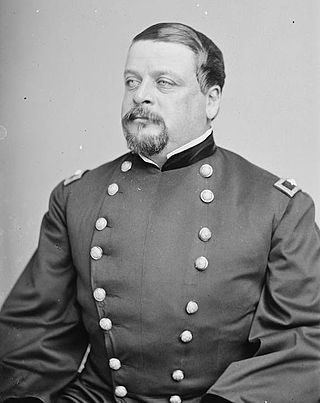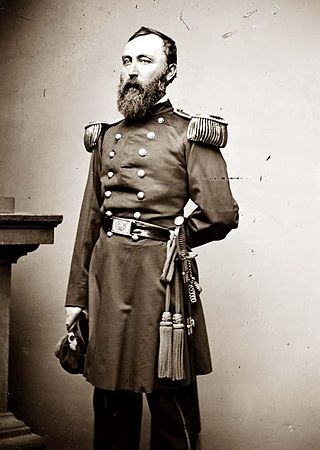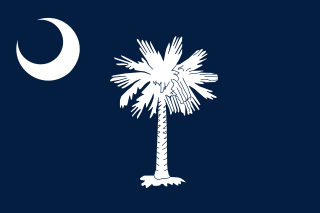Related Research Articles

There were five corps in the Union Army designated as II Corps during the American Civil War. These formations were the Army of the Cumberland II Corps commanded by Thomas L. Crittenden from October 24, 1862, to November 5, 1862, later renumbered XXI Corps; the Army of the Mississippi II corps led by William T. Sherman from January 4, 1863, to January 12, 1863, renumbered XV Corps; Army of the Ohio II Corps commanded by Thomas L. Crittenden from September 29, 1862, to October 24, 1862, transferred to Army of the Cumberland; Army of Virginia II Corps led by Nathaniel P. Banks from June 26, 1862, to September 4, 1862, and Alpheus S. Williams from September 4, 1862, to September 12, 1862, renumbered XII Corps; and the Army of the Potomac II Corps from March 13, 1862, to June 28, 1865.
The Philadelphia Brigade was a Union Army brigade that served in the American Civil War. It was raised primarily in the city of Philadelphia, Pennsylvania, with the exception of the 106th regiment which contained men from Lycoming and Bradford counties.
The 106th Pennsylvania was a volunteer infantry regiment which served in the Union Army during the American Civil War. It was part of the famous Philadelphia Brigade, which helped defend against Pickett's Charge in the Battle of Gettysburg.

George Childs Burling was a United States Union Army officer during the American Civil War, serving mostly as colonel and commander of the 6th New Jersey Volunteer Infantry. Burling was born in Burlington County, New Jersey, raised on his father's farm and educated at a private school in Norristown, Pennsylvania. He was a coal merchant and a militia officer before the war. Burling's militia company was mustered into the volunteer service for a three-month term in July 1861, but it became company F of the 6th New Jersey with a three-year enlistment on September 9, 1861. Burling became the regiment's major on March 19, 1862, and lieutenant colonel on May 7 of that year. Burling was wounded at the Second Battle of Bull Run in August 1862.

The 118th Pennsylvania Regiment was a volunteer infantry regiment in the Union Army during the American Civil War. They participated in several major conflicts during the war including the Battle of Gettysburg, Siege of Petersburg, and escorted the truce flag of Robert E. Lee at the Battle of Five Forks. The regiment was led by Colonel Charles Prevost until he was seriously injured at the Battle of Shepherdstown in which Lieutenant-Colonel James Gwyn assumed command until the end of the war.
The 142nd Pennsylvania Volunteer Infantry was a volunteer infantry regiment that fought in the Union Army during the American Civil War. The regiment primarily served in the Army of the Potomac in the Eastern Theater and was heavily engaged in the first day of fighting at Gettysburg.

Alfred Gibbs was a career officer in the United States Army who served as an officer during the Mexican-American War and Apache Wars. He served as a brigadier general in the Union Army during the American Civil War.

The 5th Michigan Infantry Regiment was an infantry regiment from Michigan that served in the Union Army during the American Civil War. The regiment was mustered into federal service in August 1861 and served in the Eastern Theater. It fought in all the major battles of the Army of the Potomac, including Seven Pines, the Seven Days Battles, Second Bull Run, Chantilly, Antietam, Fredericksburg, Chancellorsville, Gettysburg, the Wilderness, Spotsylvania, Cold Harbor, Petersburg, and Appomattox. The regiment was mustered out in June 1865.

The Iron Brigade, also known as The Black Hats, Black Hat Brigade, Iron Brigade of the West, and originally King's Wisconsin Brigade was an infantry brigade in the Union Army of the Potomac during the American Civil War. Although it fought entirely in the Eastern Theater, it was composed of regiments from three Western states that are now within the region of the Midwest. Noted for its excellent discipline, ferocity in battle, and extraordinarily strong morale, the Iron Brigade suffered 1,131 men killed out of 7,257 total enlistments: the highest percentage of loss suffered by any brigade in the United States Army during the war.

Jacob Bowman Sweitzer was a Pennsylvania lawyer and soldier who commanded a regiment and then a brigade in the Army of the Potomac in the American Civil War. He and his men were significantly engaged at the 1863 Battle of Gettysburg, where they reinforced and helped temporarily stabilize the Union defensive line on the second day of fighting.

William Stowell Tilton was an American businessman and soldier who led a regiment, and occasionally a brigade, in the Army of the Potomac during the American Civil War. He and his men were heavily engaged in the Battle of Gettysburg, where Tilton's performance created controversy.

The 18th Georgia Infantry Regiment was an infantry regiment in the Confederate Army during the American Civil War. Originally brigaded with the three Texas regiments of John Bell Hood's Texas Brigade, it was transferred to Thomas R.R. Cobb's Georgia Brigade after the Battle of Antietam in late 1862. After General Cobb was mortally wounded at the Battle of Fredericksburg, the original colonel of the 18th Georgia, William T. Wofford, became Brigadier General of the Georgia Brigade.

The 140th New York Infantry Regiment was a volunteer infantry regiment that was created on September 13, 1862, for the Union Army during the American Civil War. From January 1864 they wore a Zouave uniform.

The 80th New York Infantry Regiment, originally designated the 20th New York State Militia Regiment, "Ulster Guard", was an infantry regiment of the Union Army during the American Civil War.

The 72nd New York Infantry Regiment was one of five infantry regiments formed by former U.S. Congressman Daniel Sickles and established as part of the Excelsior Brigade which fought with the Union Army during multiple key engagements of the American Civil War, including the Chancellorsville Campaign in Virginia, the Battle of Gettysburg in Pennsylvania, and the Overland Campaign. Leaders from the 72nd New York recruited men from New Jersey, as well as from cities and small towns across the State of New York.

The 57th Regiment Pennsylvania Volunteer Infantry was an infantry regiment that served in the Union Army during the American Civil War.

The 111th Pennsylvania Volunteer Infantry was an infantry regiment that served in the Union Army during the American Civil War. It was noted for its holding the high ground at the center of the line at Antietam as part of Stainrook's 2nd Brigade, Greene's 2nd Division of Mansfield's XII Corps.

The 2nd South Carolina Infantry Regiment, also known as 2nd Palmetto Regiment, was a Confederate States Army regiment in the American Civil War.
The 13th Mississippi Infantry Regiment was a unit of the Confederate States Army from Mississippi. As part of the Army of Northern Virginia, the 13th Mississippi took part in many battles of the Eastern theater of the American Civil War, as well as some battles in Georgia and Tennessee. The 13th Mississippi Regiment surrendered at Appomattox Court House on April 9, 1865.
The 17th Mississippi Infantry Regiment was a unit of the Confederate States Army from Mississippi. As part of the Army of Northern Virginia, the 17th Mississippi fought in many of the bloodiest and most decisive battles of the Eastern theater of the American Civil War. After suffering heavy losses in battle, the remnants of the 17th Mississippi Infantry surrendered with Robert E. Lee's forces at Appomattox Court House on April 9, 1865.
References
- ↑ Heverly, Clement F. (1998). Our Boys in Blue. Sayre, Pennsylvania: Murrelle Printing Company. p. Vol 2, 432.